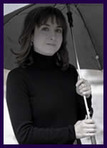Amanda McCabe's Blog, page 9
February 11, 2023
Weekend Links

A few things to add to your weekend reading!!
Charles Dickens' summer home is for sale
The mysterious viscountess/Victorian photographer
British Library extension gets green light
Celebrating the style of Princess Margaret on the anniversary of her death
15th century wine ship resurrection
Waterloo bodies found in attic
February 8, 2023
Time Traveling
(another re-post from the Risky Regencies blog, this one from way back in 2017 but still so true!)
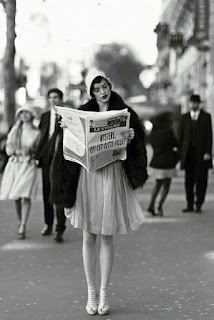
I’ve been very busy lately, having just finished a Regency Christmas story, working on a new 1920s mystery series, planning the next Elizabethan mystery, and plotting a new romance series set in Victorian Paris. I feel like I need a Tardis to take me to every time period where I need to go right now!
I do enjoy getting to explore time periods, discovering how human nature hasn’t changed and never will, and the very different ways people in different times interpret and deal with that nature. There’s always love, anger, greed, family, compassion, sacrifice, power, and it’s fascinating to think about how a person would wield those emotions in a world different from our own. But I also see how all these time periods (Elizabethan, Regency, Victorian, and the 1920s) have something in common with the era we are living through right now—they were moments of vast and swift change in the way the world works and how people deal with those changes.
The Elizabethans were exploring the globe in ways never seen before, as well as being ruled by a woman (!!), dealing with changes in religion and government, and seeing the explosion of the arts in a way never seen before or since.
The Regency was a bridge between the Enlightenment and revolution and the world of the Victorians, a moment of Whiggery and moral openess (at least among the upper classes!) and unpopular monarchies, while the Victorians saw the agrarian way of life that had gone on for centuries shift to cities and new jobs in industry (for better and also for much worse). The railroads and telegraph systems opened the world to common people in a new way as well. Oh, and there was also a woman on the throne again! (A woman who projected a new image of domesticity and respectability, in contrast to her uncles, though she was not such a prude as all that in her real life…)
Right now, I am living in the 1920s, seeing the world through an artist of the period’s eyes. Art was seeing major changes after the Armory Show, and women could now vote, drive cars, have jobs beyond nursing and teaching (or at least the possibility of such things, for the first time). World War I had changed everything.
Of course, there are also fun parts of research, and one of those is finding silly slang to use. For instance:
A silly person could be: “bacon-brained” (in the Regency) or “nerts” (in the 1920s)
Money could be: “blunt” (Regency) or “cake” (1920s)
A spirited woman could be: a “bearcat” (1920s), and “out and outer” (Regency), or “a filly” (Victorian)
Something pleasing is; “Berries!” (1920s), or (my favorite) “bang up to the elephant” (Victorian)
A wallflower could be “a cancelled stamp” (1920s), an engagement ring “handcuffs”
Nonsense could be: “Phonus balonus!” (1920s—I am using this one in real life now!) or “Fustian!” (Regency)
Of course, the best slang always has to do with being drunk. Can you guess the time periods here” “Half seas over,” “Ossified,” “Spiffilicated,” “A trifle disguised,” “Half-rats,” “In one’s cups”. Being on a bender could be “On a toot,” “Top heavy,” or “Benjo.”
What are some of your favorite time periods???
February 7, 2023
Queen of the Regency Goth
A re-post of an article I wrote for the Risky Regencies blog!
Gothic writer Ann Radcliffe died on February 7, 1823, and I always like to take another look at some of her tales….they would be perfect for a Halloween theme party!
Author Ann Radcliffe died on this date in 1823. She could be called “Queen of the Gothic novel,” as many of the standard elements of her plots can still be found in novels today, such as innocent heroines, dark, mysterious heroes, dramatic settings, and wicked villains. (And she was the most popular writer of her own day, influencing Keats and Scott among others, and forming the centerpiece of Catherine Morland’s literary obsessions in Northanger Abbey).
She was born in London in 1764, the only child of William and Anna Ward, and married William Radcliffe at age 22. (Radcliffe was a lawyer, and later editor and owner of The English Chronicle). Ann was said to be shy and reclusive, so not much was known about her private life, which gave rise to many rumors. (She had gone mad as a result of her terrible imagination and been sent to an asylum! She had been captured as a spy in Paris! She ate rare pork chops before bed to stimulate nightmares for her novels!)
J.M.S. Tompkins writes that in all Radcliffe’s novels “a beautiful and solitary girl is persecuted in picturesque surroundings, and, after many fluctuations of fortune, during which she seems again and again on the point of reaching safety, only to be thrust back again into the midst of perils, is restored to her friends and marries the man of her choice.” Sounds like the Victoria Holt stories I was addicted to as a teenager
 Her best known works include A Sicilian Romance (1790), The Romance of the Forest (1791), The Italian (1796), and of course The Mysteries of Udolpho. She also wrote a travelogue, A Journey Through Holland and the Western Frontier of Germany (1795) and various poems, which were published by her husband after her death along with the historical romance Gaston de Blondville.
Her best known works include A Sicilian Romance (1790), The Romance of the Forest (1791), The Italian (1796), and of course The Mysteries of Udolpho. She also wrote a travelogue, A Journey Through Holland and the Western Frontier of Germany (1795) and various poems, which were published by her husband after her death along with the historical romance Gaston de Blondville.
 More information can be found (mostly on the books, since the details of her life are still obscure–though I doubt the pork thing) in Deborah Rogers’ Ann Radcliffe: A Biography-Bibliography(1996). Have you ever read any of Radcliffe’s works? Have any favorite modern Gothic authors?? I’m thinking a Mysteries of Udolpho-theme Halloween party would be lots of fun…
More information can be found (mostly on the books, since the details of her life are still obscure–though I doubt the pork thing) in Deborah Rogers’ Ann Radcliffe: A Biography-Bibliography(1996). Have you ever read any of Radcliffe’s works? Have any favorite modern Gothic authors?? I’m thinking a Mysteries of Udolpho-theme Halloween party would be lots of fun…
Have you ever read any of Radcliffe’s books? Have any favorite modern Gothic authors? And what might you wear to my Halloween party???
February 5, 2023
Book sale!
Weekend Links

It's almost not the weekend any more, I know! It's been a busy one here, with revisions to finish and dogs to root out from under the blankets so they can take their walks. (Like their mom, they don't like the cold so much...) But here are a few reads to keep us busy!
The dress diary of Mrs. Anne Sykes (circa 1830s)
A Brief Compendium of Preserved Pieces of Cake
Unpacking My Ambivalence Towards Joy (a beautiful essay)
Hildegarde of Bingen Composes the Cosmos
Henry VIII's necklace discovered by a metal detectorist!
The first "ordinary woman" in English literature
Princess Diana's Gown Sells for over $600,000
3 things to do if you wake up in the middle of the night (for insomniacs like myself)
January 28, 2023
Fun Weekend Links
Hope you are all having a lovely Saturday! It's cold here, but I am snuggled under the quilts working on some book revisions, and going to the content mine to find stuff for us to read....

Pride and Prejudice was published on this day in 1813!
7 items you should always buy vintage
Elizabethan book pirates (sadly, this is nothing new...)
Women warriors who served wine on the battlefield
What was the White Ship Disaster?
The new Renaissance of feminist bookstores
January 25, 2023
Book Sale!
Some pre-orders are 25% off at Barnes and Noble right now, including "A Manhattan Heiress in Paris"! I absolutely loved writing this book. Paris! Jazz! A hero I swooned for! I hope readers love it, too...
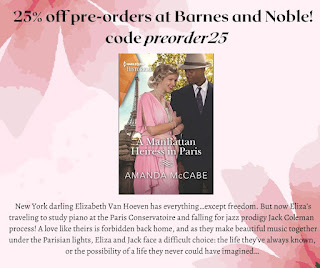
January 24, 2023
Book Release Day!!!
Lady of Seduction" (third in the Daughters of Erin" trilogy) is out in the world today!!! I am so excited.
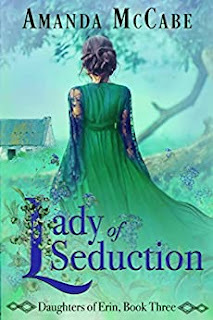
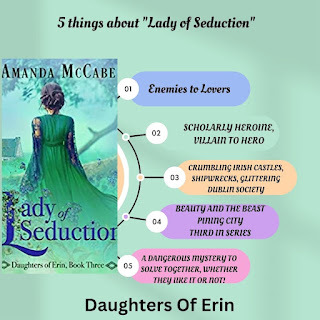
It's a mad, ill-advised journey that leads the usually sensible Lady Caroline Blacknall to the legendary isle of Muirin Inish, off the windswept coast of Ireland. Even so, she doesn't expect to find herself shipwrecked and then rescued by a man she believed she would never see again. A man who, long ago, held her life in his hands . . . and with it, her heart.
Reformed rake Sir Grant Dunmore knew he could never forget the beautiful woman he once endangered nor will he ever forgive himself. But history seems doomed to repeat itself, for as long as Caroline stays on the island, she is trapped in a secret plot that could forever free Ireland-or turn deadly for all. And yet, now that she is in his arms again, how can he dream of ever letting her go?
I can tell you that the enjoyment I had from reading this installment has encouraged me to pick up the rest of the trilogy! McKee pens a lush and fabulous historical romance that will steal your heart and make you smile. I strongly encourage any romance reader to try her work.” --The Season"
“DUCHESS OF SIN was a truly remarkable book that I could not turn away from. Much to my delight, I found that I had read from cover to cover in one setting! I loved how Laurel McKee was able to include Irish history into the story. An Irish romance was remarkably refreshing, the Gaelic lore and old words enriched the story, making it a one-of-a-kind read. Truly an amazing tale, a love to warm the heart and an adventure that never ended. I found myself enraptured by Conlan and Lady Anna, by the surprising love I felt for the Angel of Kildare, and the strong desire for the nextstory.” --Fresh Fiction
January 21, 2023
Weekend Links
Happy mid-January, everyone! My birthday is past, and now I am just huddled down in the cold trying to finish this WIP (Christmas in Gilded Age New York!). Brrr. Luckily I have lots of books, tea, and writing to keep me busy until the sun peeks our way again.
 (Check out this adorable "The Holiday" mug a friend gave me for Christmas!! It's so perfect for my mood right now)
(Check out this adorable "The Holiday" mug a friend gave me for Christmas!! It's so perfect for my mood right now)
In the meantime, here are some reads to distract us...
Happy birthday, Christian Dior! Born on this day in 1905
Quiz: Which Skeldale House resident are you? (I'm Mrs. Hall!)
Researchers discover what's inside medieval pendant
Marie Antoinette's Wardrobe Book
Two paintings by Queen Victoria are up for auction
New exhibition at Buckingham Palace on Georgian fashion
The 10 shortest reigns in English history
Women-only restaurants in the 19th century
January 16, 2023
The coronation of Elizabeth I
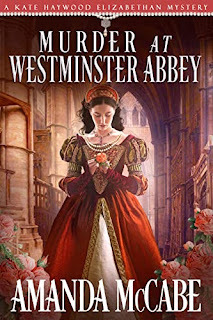
(A blog post re-run today! Yesterday, January 15, as well as being This Author's birthday, is the anniversary of Elizabeth I's coronation in 1559! I had lots of fun researching the event as the backdrop of my mystery Murder at Westminster Abbey...)
Synopsis: January 1559. Life at the center of the new royal court is abuzz with ambition and gossip—very different from the quiet countryside, where Kate served Elizabeth during her exile. Making her way among the courtiers who vie for the new queen’s favor, Kate befriends Lady Mary Everley. Mary is very close to Elizabeth. With their red hair and pale skin, they even resemble each other—which makes Mary’s murder all the more chilling.
The celebrations go on despite the pall cast over them. But when another redhead is murdered, Kate uncovers a deadly web of motives lurking just beneath the polite court banter, and follows the trail of a killer whose grievance can only be answered with royal blood.
When I started writing Murder at Westminster Abbey, I had lots of fun digging through boxes looking for photos and scrapbooks of my trips to England, and I got to revisit my very first visit to Westminster Abbey! It was a rainy, stormy day, and I had just arrived in London after a long overnight flight. The hotel room wasn’t yet ready, I was jet-lagged and a bit silly with lack of sleep and too much Chardonnay (I am a terrible flier!). So what could be better than a few hours wandering around in the cool darkness of Westminster Abbey, out of the rain?
For a lifelong history geek like me, the Abbey was a magical place. I spent hours at Poet’s Corner, visiting Chaucer and Browning. I stumbled across Anne of Cleves, Margaret Beaufort, and Aphra Behn, and stood atop where Oliver Cromwell once lay, before the Restoration came and he was dug up again. Best of all, I found myself nearly alone for a few precious minutes at the tomb Elizabeth I shares with Mary I.
It was wonderful to revisit my memories of that trip (and re-watch a DVD of William and Kate’s wedding, just for research on cathedral details, of course!). It was also a lot of fun to delve deeply into the events surrounding Elizabeth I’s coronation—I almost feel like I could have been there now, and met all the historical figures who played a part in the glittering events. I loved weaving the real pageantry with my fictional characters and what happened to them on those momentous days in January 1559.
 Queen Mary’s funeral was on December 14, 1558, and Elizabeth then moved to Whitehall Palace to celebrate the Christmas season with a series of feasts and dances, organized by her newly appointed Master of the Horse, Robert Dudley. But there was work to be done as well as dancing, a household to organize, counselors to appoint, and a coronation to plan. The city, which had been quiet and somber for the last months of Queen Mary’s sad life, sprang to life. Viewing stands were built, streets graveled, the river cleaned up, and vast quantities of cloth of gold and silver, silks, velvets, and satins were ordered. Seven hundred yards of blue cloth was laid as a carpet from Westminster Palace to the Abbey. Despite the economy of re-making Queen Mary’s royal robes for Elizabeth’s more slender figure, the Exchequer paid out more than 18,000 pounds.
Queen Mary’s funeral was on December 14, 1558, and Elizabeth then moved to Whitehall Palace to celebrate the Christmas season with a series of feasts and dances, organized by her newly appointed Master of the Horse, Robert Dudley. But there was work to be done as well as dancing, a household to organize, counselors to appoint, and a coronation to plan. The city, which had been quiet and somber for the last months of Queen Mary’s sad life, sprang to life. Viewing stands were built, streets graveled, the river cleaned up, and vast quantities of cloth of gold and silver, silks, velvets, and satins were ordered. Seven hundred yards of blue cloth was laid as a carpet from Westminster Palace to the Abbey. Despite the economy of re-making Queen Mary’s royal robes for Elizabeth’s more slender figure, the Exchequer paid out more than 18,000 pounds.
Dr. John Dee, the new queen’s favorite astrologer, laid out a horoscope predicting January 15 as the best date for the coronation. He didn’t predict the fact that the weather would be gray, cold, and icy, but the party went on. On January 12, the queen boarded her barge at Whitehall and processed along the Thames to the Tower, where new monarchs traditionally slept before their coronation. Accompanied by dozens of other barges, musicians, the Mayor and his aldermen, she floated past hundreds of people lining the riverbanks to toss flowers and shout their approval. (The poor victim in my story, Nell, watches this procession before she sadly loses her life. She’d heard from her grandmother about Queen Anne Boleyn’s procession, and wants to see Queen Anne’s daughter go by now…)
On leaving the Tower, Elizabeth processed four miles through London, wearing 23 yards of cloth of gold and silver trimmed with ermine, riding in a white litter lined with gold and drawn by white mules. Trumpeters proceeded her, and her household rode behind, dressed in their finest red velvets and furs to watch five stately pageants that symbolized the new beginning of the reign. I loved having my heroine, Kate Haywood, ride behind the queen, taking it all in.
As for the coronation itself…you will just have to read Murder at Westminster Abbey for a glimpse of it!
Here are a few of the resources I found useful:
–Greville Cook, Queen Elizabeth And Her Court Musicans (Musical Times, 79, 1918)
–AL Rowse, Elizabeth’s Coronation (History Today, III, 1953)
–Lawrence E. Tanner, The History and Treasures of Westminster Abbey, 1953
–Neville Williams, The Coronation of Elizabeth I (Quarterly Review, 597, 1953)
–WI Woodfill, Musicians in English Society from Elizabeth to Charles I (1953)


